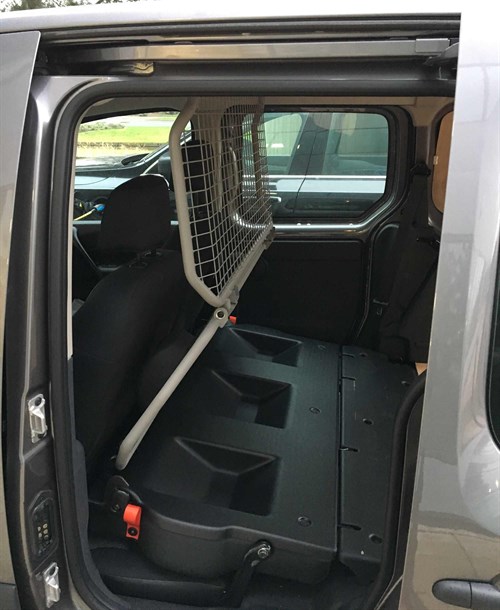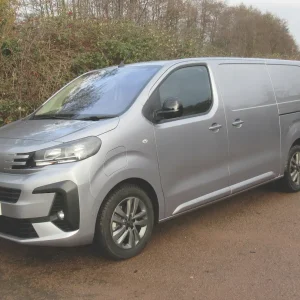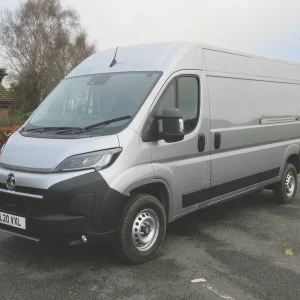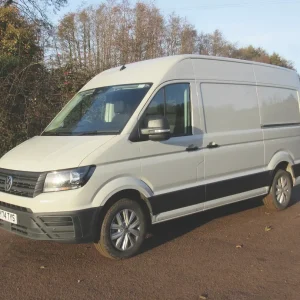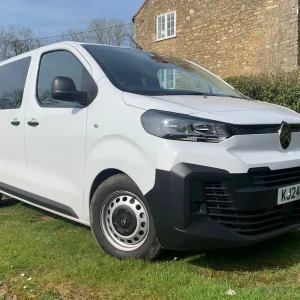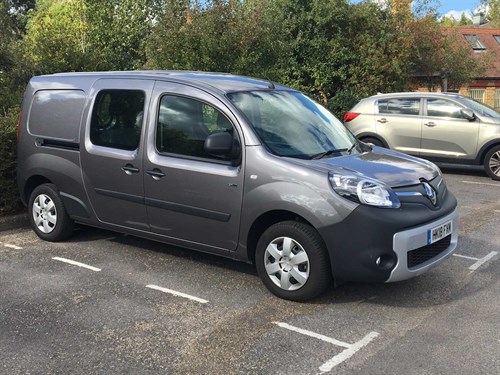
I’ve now said goodbye to my Kangoo Maxi Z.E. having lived with it for more than half a year, a period that highlighted the pros and cons of running a plug-in van in an urban environment.
The good news is that the pros are in the ascendancy. The Kangoo Maxi Z.E. and its little brother the Kangoo Z.E. are capable and practical vans boasting impressive load-lugging chops and, with the latest batteries installed, they can now go further and longer between charges.
With the Ultra Low Emission Zone (ULEZ) going live in London this month (April) and with other conurbations set to follow suit with similar schemes, the case for delivery businesses and indeed small traders to go electric is becoming more compelling.
It’s no longer just those wishing to be seen to be green who are choosing electric vans, with diesels being priced out they are becoming more financially viable too. Having pioneered the technology since launching its first plug-in Kangoo in 2011, Renault will be confident its time has finally come.
In 2017 the manufacturer upgraded the Z.E., installing new 33kW batteries and a 60hp motor that increased range by 50% to 170 miles on the New European Driving Cycle (NEDC), or a claimed 124 miles under real-world conditions, although the brand admits this can fall to 75 miles in winter, which I can vouch for having seen how quickly the charge gauge can fall in cold conditions.
Full battery charging time from empty has been reduced from eight to six hours and although a one-hour top-up charge can deliver an extra 22 miles, this is not really adequate unless you follow a rigid and predictable timetable.
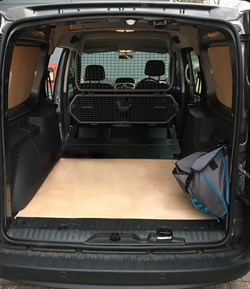
For fleets that can charge up overnight and then top-up at lunchtime to complete their afternoon assignments it’s fine, but for those needing more flexibility it’s restrictive. A fast-charging facility, such as that on the Nissan eNV200, which enables charging from 20% to 80% in under an hour, would be useful.
There are wider charging issues too, which result from the lack of a unified strategy.
Renault supplied my Kangoo Maxi Z.E. with a thick wallet of cards to cover all the different charging networks, Source London being the one I used most frequently, but other companies, like Podpoint, work via a smartphone app.
If you have to rely on the public infrastructure then prepare for range anxiety.
In residential areas or high streets points are often occupied, usually by a hybrid vehicle in my experience, or broken or fitted with an incompatible cable, so make sure you carry one in your van.
But these problems will, we trust, be overcome and on urban routes the Z.E.’s one-speed automatic transmission makes for a serene and stress-free drive, a feeling enhanced by the near silence of the ride.
Instant torque leads to zippy acceleration while regenerative braking means you don’t have to use the brake half as often as you do in a conventional vehicle because the van slows itself automatically when the throttle is released.
The Maxi Z.E.’s cabin is basic but the controls are big and user-friendly.
The seven-inch touchscreen, however, is positioned a long way from the driver’s seat so is difficult to use, but it does display clear information about the van’s energy usage.
A large dial on the dashboard directly in the driver’s line of vision also supplies details of the battery’s charge status, and a button on the steering column provides a click-through menu that tells you how many kW per mile the vehicle is using up and how many miles of range remain. There are issues to overcome, but overall the Kangoo Maxi Z.E. makes sense in the city.
Renault Kangoo Maxi Z.E. 33 Crew Van
Mileage 2,380
Official range 170 miles (NEDC)
Our average consumption 3.2mi/kWh
Price Range (ex VAT, inc. PiVG) £14,194-£16,778*
Price (ex VAT) (inc PiVG) £15,334*
Warranty 4yrs/100,000mls
Service intervals 2yrs/36,000mls
Load length 1,361mm
Load width (min/max) 1,145/1,219mm
Load bay height 1,129mm
Load volume 2.4m3
Gross payload 539kg
Engine power 60hp
Gearbox 1-spd auto
CO2 0g/km
* Plus battery rent from £49 pcm
End-of-term Report
City driving = 4/5
The Z.E. is easy to manouevre and offers decent load-carrying capacity to urban operators.
Cabin = 3/5
The switchgear is a bit dated but generally easy to use with good info about the Z.E.’s energy usage and mileage range.
Range/Charging = 3/5
The extended range of the Z.E. 33 keeps anxiety at bay but there is room for improvement in the fragmented recharging network.
Load bay = 3/5
The Kangoo Maxi Z.E. offers practical and versatile load-carrying solutions.
Versatility = 3/5
Cold temperatures can expose the Z.E.’s limitations – but it still works as an urban runaround.
Real-world practicality = 4/5
The Maxi Z.E. is a competent and practical urban van, but a fast-charging facility would make it even better.
Overall score 67%
Click below to see previous report
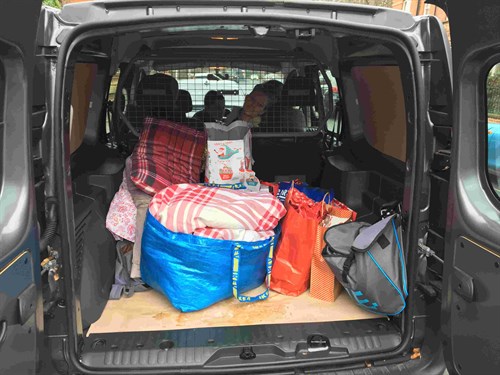
5th Report
Piloting an electric van during the winter gives you a good idea of how really cold conditions can affect its performance and comfort.
The first thing to be aware of is how chilly weather may affect the vehicle’s potential range.
Unless you have a fondness for Arctic temperatures or for wrapping yourself up in all your winter woollies before getting behind the wheel, then you are going to need to whack the heater up to the max.
Even then it takes a good while for the interior in our Kangoo Maxi Z.E. to warm up because much of the heat is lost to the loading bay, from which the double-cab is protected by an otherwise impressively versatile mesh bulkhead.
But more importantly, Renault admits that the Z.E.’s fully-charged range drops from an estimated real-world 124 miles in temperate conditions to as low as 75 miles in the winter, so you need to plan journeys carefully.
Selecting Eco mode will ensure you eke the most mileage out of the battery, but this is offset by a significant loss of grunt, so doesn’t really work if you want to make use of the 539kg payload.
Although I regularly made trips with five occupants in the cabin over the winter period, I carried bulky rather than heavy materials, for which the Maxi Z.E.’s load box proved ideal. A simple but worthwhile feature is the ply-lining that protects the floor and walls of the cargo area from any scrapes or scratches its contents may incur.
Report Card: Versatility = 3/5
Cold temperatures can expose the Z.E.’s limitations – but it can still work well as an urban run-around.
Renault Kangoo Maxi Z.E. 33 Crew Van
Mileage 2,300
Official range 170 miles (NEDC)
Our average consumption 3.2mi/kWh
Price Range (ex VAT, inc. PiVG) £14,194-£16,778*
Price (ex VAT) (inc PiVG) £15,334*
Warranty 4yrs/100,000mls
Service intervals 2yrs/36,000mls
Load length 1,361mm
Load width (min/max) 1,145/1,219mm
Load bay height 1,129mm
Load volume 2.4m3
Gross payload 539kg
Engine power 60hp
Gearbox 1-spd auto
CO2 0g/km
* Plus battery rent from £49 pcm
Click below to see previous report
4th Report
Having been the custodian of an electric van for nigh on half a year it’s struck me that I’ve spent a good deal of that time preoccupied with the related issues of battery charging and how far I can get once charged.
Will the charge point be free?
Have I got the right charging card?
Will the charging network app work?
Can I make it to the destination without a recharge?
These concerns tend to overshadow the fact that an electric van is still a van: a load-carrying working tool like any other but one that can access all urban areas without increasing levels of air pollution or incurring congestion charge or low-emission-zone fees.
Okay, so there may be a slight payload penalty to consider due to the weight of the battery, but with light vans, rather than their larger stablemates, which are likely to be required to carry heavier loads, and with the technology improving apace, this should quickly become less of a headache for operators.
Our Maxi Z.E. Crew Van has a payload of 539kg, which compares to 740kg for the equivalent diesel model. For urban-based parcel delivery firms or tradespeople carrying materials and tools to job sites, the electric van’s provision is likely to be sufficient.
The load area, timber-lined on our van, is reached by means of twin, glazed, asymmetric doors with the narrower of the pair on the offside.
The doors can be swung through 180° and the door stays are easy to release. When opened to 90°, the doors are held in place by a mechanism that stops them slamming shut in gusts of wind.
Rear seat passengers get in and out via sliding doors on both sides of the van, but when the rear bench is not in use a clever feature allows you to fold it down to increase the load volume from 2.4m3 to 3.6m3 while protecting the occupants of the front two seats with a multi-positional mesh bulkhead that follows the position of the rear bench (see picture). The top half of the bulkhead folds neatly under the roof when the rear seats are in use.
Over the winter break I was able to comfortably fit two bikes in the load bay with the rear seats down, while with five people on board there was ample room for Christmas presents and luggage.
Report Card: Load bay = 3/5
The Kangoo Maxi Z.E. offers practical and versatile load-carrying solutions to urban operators.
Renault Kangoo Maxi Z.E. 33 Crew Van
Mileage 2,230
Official range 170 miles (NEDC)
Our average consumption 3.2mi/kWh
Price Range (ex VAT, inc. PiVG) £14,194-£16,778*
Price (ex VAT) (inc PiVG) £15,334*
Warranty 4yrs/100,000mls
Service intervals 2yrs/36,000mls
Load length 1,361mm
Load width (min/max) 1,145/1,219mm
Load bay height 1,129mm
Load volume 2.4m3
Gross payload 539kg
Engine power 60hp
Gearbox 1-spd auto
CO2 0g/km
* Plus battery rent from £49 pcm
Click below to see previous report
3rd Report
Range anxiety is the bane of life for the manufacturers of electric vans striving to convince customers they really should plug into the zeitgeist and switch from diesel to battery power.
OK, electric propulsion is not suitable for all applications, which, to their credit, is a fact electric vehicle manufacturers have been keen to make operators aware of.
Education is vital for the market to gain a good understanding of where the technology should be used. A business that relies on running vans between London and Manchester, for example, should not be choosing electric ones, but for urban operators the choice to go electric should be compelling. The Plug-in Van Grant eases the upfront cost burden, they are exempt from low-emission zone charges and, if following predictable routes, should remain comfortably within the vans’ battery ranges.
For organisations that can recharge fleets of plug-in vans at chargers installed at their premises the transition to battery power should be anxiety-free – take, for example, UK Power Networks, an electricity distribution network operator, which has installed 27 charge points across six London locations to keep a recently acquired fleet of Kangoo Z.E.s on the road.
But for owner-driver traders moving to electric may not be so easy.
Cities are the natural habitat for EVs, but streets of Victorian terraced houses facing directly onto the pavement without driveways – let alone garages – or blocks of high-storey residential flats are not compatible with home charging, so you have to rely on an infrastructure that may be growing but remains fragmented.
I’ve been running my Kangoo Maxi Z.E. within London and the M25 belt where there are several charging point suppliers – Pod Point, Polar, Zero Net and Source London, to name but a few.
Each of these requires its own card or app to activate charging. A Pod Point Twin open point installed at What Van?’s office has facilitated my commute by enabling me to recharge the Maxi Z.E. while I’m at work.
Once downloaded onto your smartphone the service is free to use, but the charge must be confirmed on the app within 15 minutes of plugging in or it will cut out. The app can tell you where Pod Point stations are located and also whether they are free (open points) or require a tariff.
When not travelling to and from work but covering varied and less predictable routes, I have relied upon other networks, with Source London being the one most common in south-east London in my experience. Placing your card onto a touchscreen before connecting your charging cable activates these points. The Source London station I’ve most frequently used has its own cable included, but it does not fit the Maxi Z.E. so I have used the electric vehicle supply equipment (EVSE) one Renault supplied.
A problem with these on-street charging points is that they are often already occupied and online services such as Zap Map, which purport to locate chargers and indicate whether they are in use, are not foolproof. I have driven to a charging station that was out of order and, judging by its state of disrepair, had been for a considerable time.
Commendably, Renault’s R-Link multimedia system enables you to programme the satnav to find charging stations – however, when I tried it, it informed me I had arrived at a charge point where one was not to be found. Considering Zap Map lists a charging station in the same spot it has either been removed or is elswhere – either way it’s not much use if you turn up with an empty battery.
Report Card: Range/Charging = 3/5
The extended range of the Z.E. 33 keeps anxiety at bay but there is room for improvement in the fragmented recharging network.
Renault Kangoo Maxi Z.E. 33 Crew Van
Mileage 1,200
Official range 170 miles (NEDC)
Our average consumption 3.5mi/kWh
Price Range (ex VAT, inc. PiVG) £14,194-£16,778*
Price (ex VAT) (inc PiVG) £15,334*
Warranty 4yrs/100,000mls
Service intervals 2yrs/36,000mls
Load length 1,361mm
Load width (min/max) 1,145/1,219mm
Load bay height 1,129mm
Load volume 2.4m3
Gross payload 539kg
Engine power 60hp
Gearbox 1-spd auto
CO2 0g/km
* Plus battery rent from £49 pcm
Click below to see previous report
2nd Report
Electric powertrains may represent the future for LCVs as they continue to move into the mainstream, but clambering into the cab of the Kangoo Z.E. is a bit like taking a step back in time.
Maxi is a bit like taking a step back in time.
The first thing to strike you is the acres of shiny black plastic stretching across the doors and over the dash to the windscreen. Rap your knuckles on it and there’s no mistaking it’s from the harder end of the spectrum too.
The switchgear is all pretty old school, with circular plastic dials controlling temperature, air flow and where you want it directed.
There are buttons for turning on the radio and navigating the infotainment options and Renault continues to provide a CD player too. The steering wheel-mounted controls are small and therefore fiddly to use.
It’s also a surprise when you set off at dusk to discover the headlamps don’t have an automatic mode and you have to turn them on yourself.
Most of the controls, however, are chunky, well-positioned and easy to use and, after all, Renault makes no pretence to sell the Z.E. 33 on the back of a fancy interior.
Where sophistication is apparent is in the central seven-inch touchscreen that provides satnav and clear info about the van’s energy usage as well as access to the DAB radio. It’s a bit of a stretch to reach it from the driver’s seat though, so needs to be operated when stationary.
A large dial on the dashboard directly in the driver’s line of vision supplies clear information about the battery’s charge status, and an, albeit small, button on the steering column provides a click-through menu that tells you how many kW per mile the vehicle is using up and how many miles of range remain.
Another plus is that pairing my iPhone and downloading its contacts was painless and it is simple to receive hands-free calls.
Report Card: Cabin = 3/5
The switchgear is a bit dated but generally easy to use with good info about the Z.E.’s energy usage and mileage range.
Renault Kangoo Maxi Z.E. 33 Crew Van
Mileage 514
Official range 170 miles (NEDC)
Our average range 120 miles (est)
Price Range (ex VAT, inc. PiVG) £14,194-£16,778*
Price (ex VAT) (inc PiVG) £15,334*
Warranty 4yrs/100,000mls
Service intervals 2yrs/36,000mls
Load length 1,361mm
Load width (min/max) 1,145/1,219mm
Load bay height 1,129mm
Load volume 2.4m3
Gross payload 539kg
Engine power 60hp
Gearbox 1-spd auto
CO2 0g/km
* Plus battery rent from £49 pcm
Click below to see previous report
1st Report
Electric LCVs may have been around for several years but until recently they have occupied a position on the periphery of the marketplace.
Local authorities may have found uses for them, and firms with a wish to ‘be seen to be green’ shouted loudly about investing in a few token examples, but mainstream fleets looked at the bottom-line practicalities and steered clear.
But now a perfect storm is gathering that looks as though it could propel EVs into the mainstream.
The anti-diesel lobby is growing more vociferous, clean-air zones and congestion charge areas are forcing conventionally-powered vehicles out of urban hubs, and other alternative fuels do not look to be as viable as plug-in power. Most importantly, range anxiety is receding as the technology improves, enabling electric vans to cover more miles between charges.
Renault has arguably contributed more to the development of electric LCVs than any other manufacturer. It launched the first plug-in Kangoo light van in 2011 but, despite the government’s provision of a 20% Plug-in Van Grant, operators were not convinced by its practicality as a real-world working van.
But last year Renault upgraded the Z.E., installing new 33kW batteries and a 60hp motor that increased range by 50% to 170 miles on the New European Driving Cycle (NEDC), or 124 miles under real-world conditions, although the brand admits this can fall to 75 miles in winter. Full battery charging time from empty has been reduced from eight to six hours and a one-hour top-up charge can deliver an extra 22 miles, according to the manufacturer.
Renault claims payload of up to 650kg for both the Kangoo Z.E. and long-wheelbase Maxi Z.E. and load volumes of up to 3.5m3 and 4.6m3, respectively correspond to the diesel van equivalents. Our crew van offers a 539kg payload and 2.4m3 load area.
So, has the time finally come for the Z.E to make its mark as a viable urban operator? We have taken delivery of a Kangoo Maxi Van Z.E. 33 crew van to find out.
First impressions are favourable. I have so far covered a route taking in a brief stretch of the M25 motorway and a longer stint of the A2 linking Kent to London, but the majority of my time has been spent negotiating the streets of south-east London. On these urban routes the one-speed automatic transmission makes for a serene and stress-free drive, a feeling enhanced by the near silence of the ride – although the sense of tranquility is disturbed at speeds of under 20mph by the spooky whine of the ‘Z.E.Voice’ that alerts otherwise potentially unsuspecting pedestrians to the vehicle’s approach.
Much of the harshness in acceleration and braking that historically characterised driving electric vehicles has been ironed out in the latest Z.E. Instant torque means you have to be careful not to stamp on the throttle however, while regenerative braking means you quickly get used to not pressing your foot on the brake half as often as you do in a conventional vehicle because the van slows itself automatically when the accelerator pedal is released. In fact, when the Z.E. is confined to urban areas, a careful driving style with Eco mode selected can make it feel as though the charge is not diminishing at all.
Out of town, however, and the van can feel like a fish out of water as it struggles to keep up with fast-moving motorway traffic while chomping through its range capacity.
So far though, the Z.E. has operated well within its comfort zone with a return commute of 38 miles using up less than a third of its charge.
Report Card: City driving = 4/5
The Z.E. is easy to manouevre and offers decent load-carrying capacity to urban operators.
Renault Kangoo Maxi Z.E. 33 Crew Van
Mileage 325
Official range 170 miles (NEDC)
Our average range 120 miles (est)
Price Range (ex VAT, inc. PiVG) £14,194-£16,778*
Price (ex VAT) (inc PiVG) £15,334*
Warranty 4yrs/100,000mls
Service intervals 2yrs/36,000mls
Load length 1,361mm
Load width (min/max) 1,145/1,219mm
Load bay height 1,129mm
Load volume 2.4m3
Gross payload 539kg
Engine power 60hp
Gearbox 1-spd auto
CO2 0g/km
* Plus battery rent from £49 pcm

